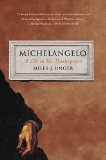Summary | Excerpt | Reviews | Beyond the Book | Readalikes | Genres & Themes | Author Bio

Critics' Opinion:
Readers' Opinion:
First Published:
Jul 2014, 448 pages
Paperback:
Jul 2015, 448 pages
 Book Reviewed by:
Book Reviewed by:
Suzanne Reeder
Buy This Book
It is possible that Condivi embellished this story, but the basic outlines are not in dispute. In 1490, Michelangelo left his shabby paternal home in the quarter of Santa Croce and moved into the magnificent Medici Palace, where, again according to his own account, Il Magnifico provided "a good room in his own house with all that he needed, treating him like a son, with a seat at his table."
In light of Michelangelo's tendency to burnish his biography, it is reasonable to treat this last characterization with caution, if not outright skepticism. Being treated like a son by the magnificent Lorenzo de?' Medici would place Michelangelo in rarefied company and remove any suspicion that he was little more than a glorified household servant. It also helped erase the embarrassing facts of his humble origins. But while the story is certainly self-serving, there is in fact plenty of evidence to suggest that in this case Michelangelo did not stray too far from the truth. Years later, when Lorenzo's second son, Giovanni, was sitting on the throne of St. Peter as Pope Leo X, he recalled the happy period when Michelangelo lived at the palace. "When he speaks of you," reported the painter Sebastiano del Piombo, "it is almost with tears in his eyes, because as he told me, you two were raised together. . . ."
No doubt there was an element of noblesse oblige in Lorenzo's kindness. He worked hard to cultivate his image as a simple citizen of Florence even as he consolidated his hold over the government, and his generosity toward talented men was a large part of the mystique that earned him the title Il Magnifico. Lorenzo's "court" was filled with men of great gifts and small means, men like the poets Luigi Pulci and Angelo Poliziano. Not only did he genuinely enjoy their company, but these eloquent and influential figures repaid his generosity in full by broadcasting his virtues to the world.
It is difficult to overstate the significance for Michelangelo of the two years he spent under Lorenzo's roof. In a very real sense, Il Magnifico was the father he wished he had and felt he deserved, a man not only of unquestioned pedigree but one who, unlike the dour Lodovico, held artists and writers in high regard. Where Lodovico cut a shabby figure, Lorenzo was magnificence itself; while Lodovico expressed his contempt for art and artists, Il Magnifico demonstrated their true worth by showering them with riches.
By focusing on his two-year residence at the Medici Palace rather than his equally brief stint as a lowly apprentice in Ghirlandaio's studio, Michelangelo created a new origin story for himself as an artist. In the palace, Michelangelo was tutored by the brilliant Poliziano and scholarly Ficino, men whose reputations as intellectuals elevated them above artists who worked with their hands. Conversing with these cultivated men, he became convinced that painting and sculpture were not merely crafts but tangible philosophy.
Of the two sculptures Michelangelo executed while in residence at the Medici Palace, one of them at least was inspired by Poliziano, who had taken the young artist's education in hand. The so-called Battle of the Centaurs depicts an obscure mythological theme of the kind beloved by the humanists in Lorenzo de?' Medici's circle. The battle between the Lapiths and the savage centaurs is an allegory of Man overcoming his bestial nature; happily for Michelangelo, it also offered an opportunity to depict the male nude in action, the theme he will explore in most of his greatest works. Michelangelo himself believed this early work contained the seeds of all he would later accomplish. Seeing this youthful exercise again after many years, he told Condivi "how much wrong he had done to his nature in not following promptly the art of sculpture, judging by that work how well he might have succeeded. . . ."
The small-scale relief also recalls the work of his first sculptural master, Bertoldo di Giovanni, whose most accomplished piece was a bronze battle scene modeled on an ancient Roman sarcophagus. Bertoldo's influence can also be detected in Michelangelo's earliest extant sculpture, the small relief known as the Madonna of the Stairs, which probably dates from 1491, the first year Michelangelo spent at the Medici Palace. The small marble of the Virgin with the infant Jesus is done in a technique that Michelangelo rarely employed, what Italians call rilievo schiacciato, or flattened relief. The form was pioneered by Donatello in the early fifteenth century and would have been familiar to his pupil Bertoldo. It is, in effect, a form of drawing in stone in which the depth of the carving does not so much correspond to three-dimensional forms as suggest them through subtle modulations of light and shadow. Vasari deems the technique, which he traces back to ancient cameos and coins, "very difficult . . . demand[ing] great skill and invention. . . ." Though the depth of the actual carving can be measured in mere millimeters, Michelangelo has managed to pack a lot into a little: a monumental Virgin Mary seated stoically on her blocklike throne; the baby Jesus twisting in her arms; and a staircase leading to another room sufficiently commodious to serve as the perch for three cherubs carrying a sheet (symbolizing the shroud that will drape the dead Christ's body).
Excerpted from Michelangelo by Miles J Unger. Copyright © 2014 by Miles J Unger. Excerpted by permission of Simon & Schuster. All rights reserved. No part of this excerpt may be reproduced or reprinted without permission in writing from the publisher.





The Flower Sisters
by Michelle Collins Anderson
From the new Fannie Flagg of the Ozarks, a richly-woven story of family, forgiveness, and reinvention.

The House on Biscayne Bay
by Chanel Cleeton
As death stalks a gothic mansion in Miami, the lives of two women intertwine as the past and present collide.

The Funeral Cryer by Wenyan Lu
Debut novelist Wenyan Lu brings us this witty yet profound story about one woman's midlife reawakening in contemporary rural China.
Your guide toexceptional books
BookBrowse seeks out and recommends the best in contemporary fiction and nonfiction—books that not only engage and entertain but also deepen our understanding of ourselves and the world around us.